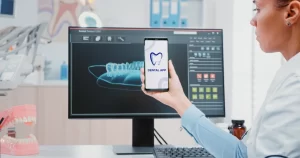In today’s rapidly evolving world, orthodontic practices are realizing the importance of boosting efficiency with advanced orthodontic software. By incorporating cutting-edge technology into their daily operations, these practices can revolutionize the way they operate and provide better patient care. This article explores the various ways in which advanced software can streamline orthodontic practices.
One of the key benefits of implementing advanced software is the ability to streamline appointment scheduling. Automated systems enable clinics to efficiently manage their schedules, minimize wait times, and enhance overall patient experience.
Additionally, advanced software enables efficient patient record management by digitizing and centralizing all relevant information. This improves accessibility and ensures accurate data storage.
Furthermore, advanced software assists in enhancing treatment planning by providing tools for visual simulations, virtual models, and treatment progress tracking. Orthodontists can create personalized treatment plans tailored to each patient’s unique needs.
Moreover, improved communication with patients is facilitated through advanced software platforms that offer secure messaging systems and telehealth capabilities. Open lines of communication foster trust and strengthen the patient-provider relationship.
Lastly, adopting advanced software helps orthodontic practices stay ahead of the competition by optimizing efficiency and effectiveness. By embracing technological advancements, practices demonstrate a commitment to innovation and excellence.
Overall, integrating advanced orthodontic software has the potential to significantly transform how orthodontic practices operate while providing enhanced levels of care for patients.
Key Takeaways
- Implementing advanced software solutions in orthodontic practices is crucial for improving patient care and enhancing the overall patient experience.
- Advanced software streamlines appointment scheduling, reduces wait times, and improves patient attendance rates through automated reminders and real-time updates.
- Efficient patient record management is achieved through digitization and centralization of information, reducing errors and improving accessibility.
- Treatment planning is optimized through advanced software and digital imaging, allowing for visual simulations and progress tracking, leading to better communication with patients and increased treatment acceptance rates.
Streamlining Appointment Scheduling
Appointment scheduling can be streamlined and made more efficient through the implementation of advanced software systems in orthodontic practices. By utilizing automated reminders, orthodontic practices can reduce the likelihood of missed appointments and improve patient attendance rates. These reminders can be sent via email or text message, ensuring that patients are constantly updated about their upcoming appointments.
Additionally, advanced software systems allow for the optimization of workflow within the practice. They enable staff members to easily view and manage appointment availability, reducing scheduling conflicts and maximizing the number of patients seen each day. Furthermore, these systems provide real-time updates on patient arrivals and cancellations, allowing for immediate adjustments to the schedule if necessary.

Overall, implementing advanced software for appointment scheduling in orthodontic practices improves efficiency, reduces administrative burden, and enhances patient satisfaction by minimizing wait times and streamlining operations.
Efficient Patient Record Management
Efficient management of patient records is crucial for the optimization of orthodontic practice operations. Automated documentation and digital imaging play a significant role in streamlining this process.
By utilizing advanced software, orthodontic practices can eliminate the need for manual record-keeping and reduce the chances of errors or lost information. Automated documentation allows for quick and accurate updates to patient records, ensuring that all relevant information is easily accessible by the dental team whenever required.
Digital imaging further enhances record management by providing a comprehensive visual representation of the patient’s oral health, enabling precise treatment planning and monitoring progress over time. This integration of technology not only improves efficiency but also enhances the overall quality of care provided by orthodontic practices, promoting a sense of belonging among patients who value modern advancements in healthcare delivery.
Enhancing Treatment Planning
The optimization of treatment planning is a critical aspect in orthodontic practice operations, as it allows for precise and personalized care delivery based on comprehensive analysis of patient data and oral health assessments.
With the advancement of technology, orthodontists now have access to advanced software that enables them to enhance their treatment planning process. Digital imaging plays a key role in this aspect, allowing practitioners to capture accurate images of patients’ teeth and jaws. These images can then be used to create virtual simulations, which provide a visual representation of the desired treatment outcomes.
By incorporating digital imaging and virtual simulations into the treatment planning process, orthodontists can better communicate with their patients, as they are able to show them the expected results before starting any procedures. This not only improves patient satisfaction but also increases treatment acceptance rates.
Improving Communication with Patients
One effective approach to fostering better patient engagement and understanding in orthodontic treatment involves utilizing digital imaging and virtual simulations to visually present expected treatment outcomes.
By incorporating advanced software into their practices, orthodontists can enhance communication with patients and provide them with a clearer understanding of the treatment process.
Digital imaging allows for accurate representations of the patient’s current dental condition, while virtual simulations can demonstrate the projected outcome after treatment.
This visual representation aids in patient engagement by allowing them to actively participate in their own care decisions.
Additionally, telemedicine options further improve communication between orthodontists and patients, providing convenient access to consultations and follow-up appointments without the need for in-person visits.
These technological advancements not only improve patient satisfaction but also contribute to more efficient and effective orthodontic treatments.
Staying Ahead of the Competition
To maintain a competitive edge in the orthodontic field, practitioners must continually seek innovative strategies and embrace emerging technologies.
One way to stay ahead of the competition is by implementing digital marketing strategies. With the advent of the internet and social media platforms, orthodontic practices can reach a wider audience and attract new patients. By utilizing targeted online advertisements, search engine optimization techniques, and engaging content creation, practices can effectively market their services to potential clients.
Additionally, incorporating telemedicine options can further enhance competitiveness. Telemedicine allows for virtual consultations and follow-ups, providing convenience for both patients and practitioners. This technology enables orthodontists to remotely monitor progress, offer guidance, and address concerns without requiring in-person visits.
By staying up-to-date with digital marketing trends and embracing telemedicine options, orthodontic practices can position themselves as leaders in the industry while better serving their patients’ needs.
Conclusion
In conclusion, implementing advanced orthodontic software can greatly transform the efficiency and effectiveness of a practice.
By streamlining appointment scheduling, managing patient records more efficiently, enhancing treatment planning capabilities, improving communication with patients, and staying ahead of the competition, orthodontists can provide better care and service to their patients.
Advanced software allows for a more streamlined and organized approach to running a practice, ultimately leading to improved patient outcomes and increased success in the field
You May Also Like:



